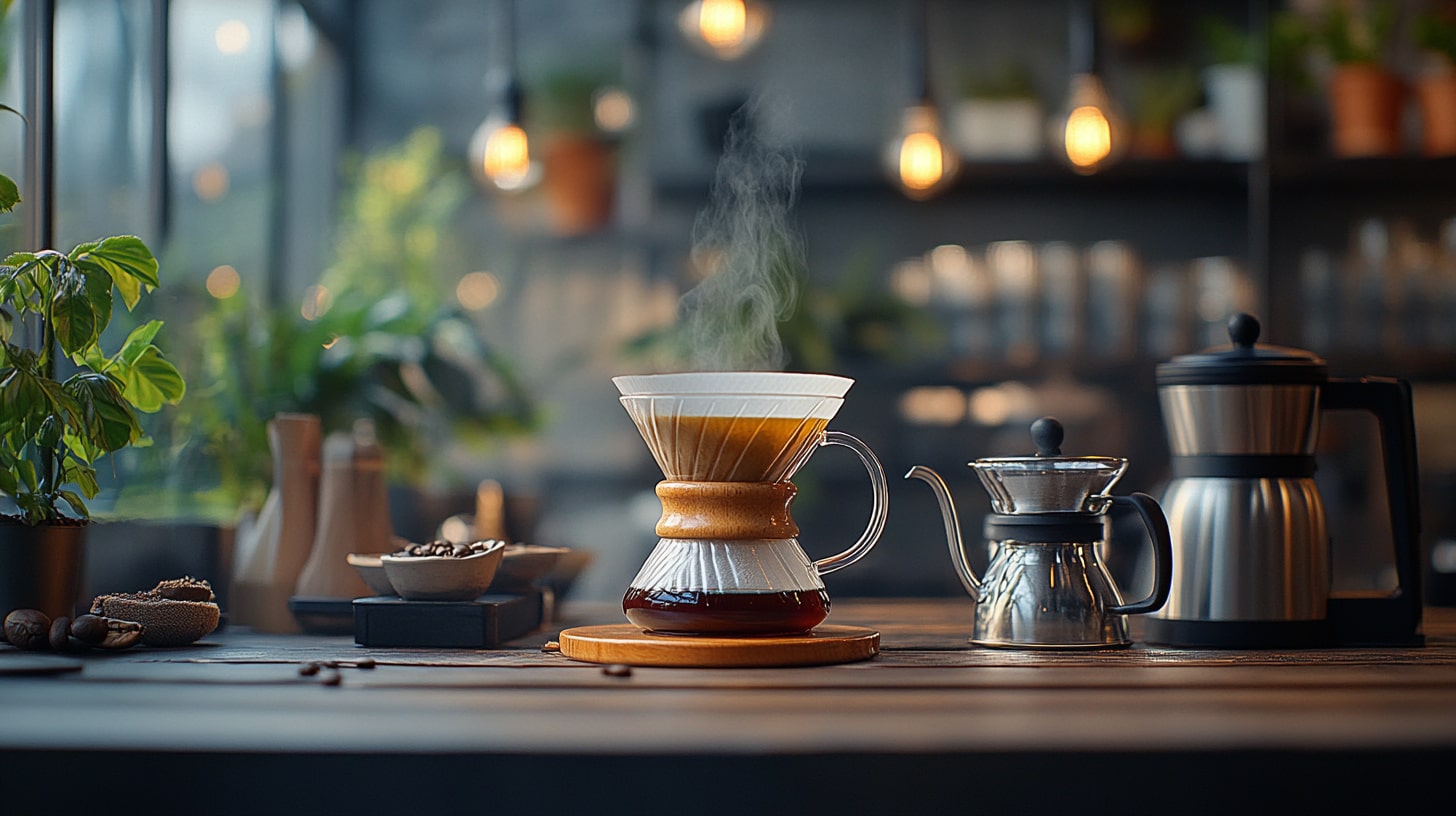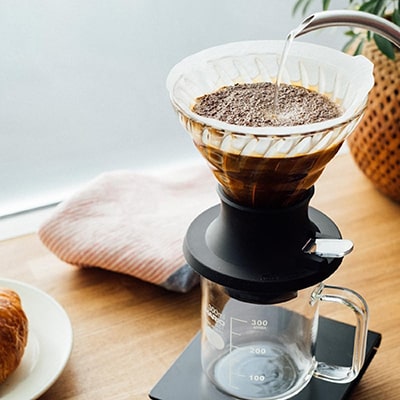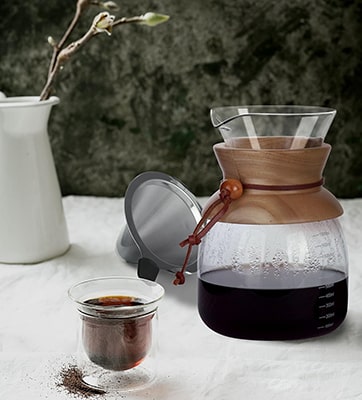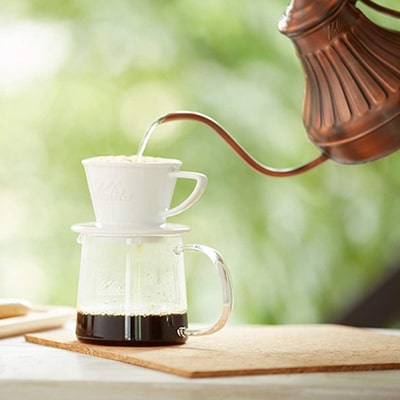Pour-Over Coffee Technique Explained: From Beans to Brewing Perfection

Affiliate Disclosure: As an Amazon Associate, I earn from qualifying purchases. This post may also contain other affiliate links, meaning I may earn a small commission if you buy through them, at no extra cost to you. Your support helps keep this site running and allows me to continue sharing great content. Thank you!
The pour-over technique has become a hallmark of modern coffee culture, captivating enthusiasts who seek a perfect brew. Revered for its simplicity and precision, this method offers an unmatched opportunity to extract deep, rich flavors from coffee beans. Unlike automated methods, pour-over brewing allows you to control every variable, grind size, water temperature, and pour speed, crafting a cup tailored to your preferences.
As the pour-over technique gains popularity, it’s more than just a method; it’s a ritual that celebrates the art of coffee making. Slowly pour hot water over freshly ground coffee. Watching the bloom and savoring the aromas turns brewing into a mindful, meditative experience. This connection with the coffee pour is both personal and deeply satisfying.
Mastering the pour-over technique not only leads to a richer, more aromatic coffee but also gives you full control over the brewing process. Whether you’re a seasoned barista or just starting your coffee journey, understanding the nuances of pour-over brewing will elevate your coffee experience.
Key Takeaways
- Pour-over coffee allows for a highly customizable brew, offering control over grind size, water temperature, and pour technique for a personalized cup.
- Essential equipment like the Hario V60, Chemex, or Kalita Wave significantly influences your coffee’s final flavor.
- Mastering key variables, grind size, water temperature, and pour speed is crucial for achieving consistent, balanced results.
- Advanced techniques, such as pulse pouring and extended blooming, can enhance the depth and complexity of your coffee.
- Choosing the right beans, especially single-origin varieties, lets you explore diverse flavor profiles based on origin and roast.
To fully experience these benefits, you’ll need the right tools. Let’s explore the essentials for crafting your perfect pour-over.
Essential Equipment and Tools
To master the pour-over technique, having the right equipment is essential. Each tool plays a vital role in extracting the best flavors from your coffee beans. Here’s what you’ll need:
- Filters: The right filter is key to a clean and crisp cup. Paper filters are popular for removing oils and fine particles, resulting in a brighter brew. Metal filters allow more oils to be absorbed, creating a fuller-bodied coffee, while cloth filters offer a middle ground, filtering most oils while preserving some. Your filter choice significantly impacts flavor and texture, so experiment to find your preference.
- Drippers: The dripper controls water flow over the coffee grounds, influencing extraction. Cone-shaped drippers like the Hario V60 promote a faster brew, highlighting brighter, delicate notes. Flat-bottom drippers like the Kalita Wave slow the process, resulting in a more balanced cup. Dripper material, ceramic, glass, or plastic, also affects heat retention, impacting the brew. Ceramic and glass retain heat better, enhancing extraction, while plastic is lightweight and portable, ideal for travel.



- Pour-Over Kettles: A gooseneck kettle is crucial for precise water flow. Its narrow spout allows for a slow, steady pour, essential for even extraction. Maintaining the correct water temperature is also key, with a recommended range of 195°F to 205°F. Gooseneck kettles often feature built-in thermometers or temperature control, helping you achieve the optimal brewing temperature.
- Grinders: Freshly grinding your coffee beans unlocks their full flavor potential. A burr grinder is highly recommended for pour-over coffee, producing a consistent grind size necessary for even extraction. While more affordable, blade grinders often create uneven grinds, leading to inconsistent brews. Start with a medium-coarse grind for most pour-over methods, then adjust to suit your dripper and taste preferences.
- Coffee Beans: The quality of your coffee beans greatly affects your brew’s flavor. Freshly roasted beans, ground just before brewing, yield the best results. When selecting beans for pour-over, consider the origin and processing method, as these influence the final cup. African beans, particularly from Ethiopia, are prized for their bright acidity and fruity notes, ideal for pour-over. Latin American beans may offer a balanced profile with nutty or chocolatey undertones. Light to medium roasts are generally preferred for pour-over, as they retain complex flavors and aromas.
- Optional Accessories: While not essential, several accessories can enhance your pour-over experience. A scale ensures precise measurement of coffee and water for consistent brewing. A timer helps track brewing time, and a coffee server allows you to brew multiple cups without sacrificing quality.
With your tools ready, it’s time to put them to work in mastering the pour-over technique.
Step-by-Step Guide to Pour-Over Coffee
Mastering the pour-over coffee technique combines precision, patience, and attention to detail. Whether you’re a beginner or refining your skills, this step-by-step guide will help you achieve a consistently perfect brew every time.
Before diving into the guide, check out this helpful video demonstrating the pour-over coffee process in action:
Step 1: Prepare Your Equipment and Workspace
Gather all the tools you need: your dripper, filter, kettle, and freshly ground coffee beans. Ensure everything is within arm’s reach for a smooth workflow. Place the filter inside the dripper and rinse it with hot water.
This step removes any paper residue and preheats your dripper and carafe, setting the stage for a cleaner, warmer brew.
Step 2: Achieve the Ideal Coffee-to-Water Ratio
The coffee-to-water ratio is crucial for extracting the best flavors from your beans. Start with a 1:15 ratio, 1 gram of coffee to 15 grams of water. Adjust to a 1:14 ratio for a stronger flavor or 1:16 for a lighter brew. Using a digital scale ensures accuracy and consistency with each cup.
Step 3: Bloom Your Coffee
Pour just enough hot water over the grounds to wet them completely. This is the bloom phase. Allow the coffee to bloom for 30 to 45 seconds, letting gases escape and paving the way for even extraction.
Expert Tip: The bloom phase is essential for even extraction. If you notice uneven extraction or an inconsistent brew, ensure your bloom phase is long enough to allow gases to escape fully.
Step 4: Master the Pouring Technique
After blooming, pour the remaining water in a slow, steady circular motion. Start from the center and move outward, ensuring even coverage of the grounds. Continue until you’ve poured all the water.
Expert Tip: Consistency is key. Focus on maintaining a steady flow throughout the pouring process to ensure even extraction, which is essential for a well-balanced cup. A controlled, steady pour prevents uneven extraction, leading to a more balanced flavor profile.
Advanced Technique – Pulse Pouring: Pour in stages rather than continuously. This method allows the grounds to settle between pours, enhancing flavor extraction and yielding a more complex cup.
Step 5: Monitor Brew Time
Aim for a total brew time of 3 to 4 minutes. Adjust your grind size or water flow if your brew takes significantly longer or shorter.
Expert Tip: If your coffee tastes bitter or weak, adjusting your grind size can help. A coarser grind reduces over-extraction (and bitterness), while a finer grind can enhance flavor in a weak brew. Curious to learn more? Head to the Grind Size section below for detailed tips.
Step 6: Avoid Common Mistakes
- Grind Size: Refer to the Precision Brewing section for guidance on selecting the right grind size to avoid issues like bitterness or weak coffee.
- Water Temperature: Keep your water between 195°F and 205°F. Too hot, and it may scald the grounds; too cool, and the brew may be flat.
- Pouring Technique: Pouring too quickly or unevenly can lead to uneven extraction. Maintain a steady flow for a balanced and flavorful cup.
Step 7: Fine-Tune the Brew
Experiment with grind size and water temperature to find your perfect brew. Small adjustments can make a noticeable difference, allowing you to personalize your coffee to match your taste preferences.
Step 8: Enjoy Your Coffee
After brewing, discard the filter and grounds, then pour your freshly brewed coffee into a mug. Savor the clean, rich flavors of your pour-over coffee.
Remember, the key to an exceptional pour-over is in the details: adjusting your grind size, fine-tuning your water temperature, and mastering your pouring technique. Each small tweak you make brings out new layers of flavor, allowing you to craft a cup that perfectly suits your taste.
Advanced Techniques: Pulse Pouring and Extended Blooming
Once you’ve mastered the basics of pour-over coffee, it’s time to fine-tune your brewing process with advanced techniques that extract the full range of flavors from your beans. By focusing on grind size, water temperature, and pouring technique, you can elevate your coffee experience to new heights.
Grind Size
As previously discussed, the size of your coffee grounds directly influences the extraction process.
While a medium-coarse grind is generally recommended, fine-tuning your grind size is critical when experimenting with advanced techniques like pulse pouring.
If your coffee tastes too bitter, a coarser grind can reduce over-extraction. Conversely, a finer grind may be the solution if your brew is too weak or sour.

Water Temperature
Water temperature remains crucial in advanced brewing. The ideal range is between 195°F and 205°F, but slight adjustments within this range can significantly impact your brew. Water closer to 205°F will produce a richer, more robust cup, while temperatures closer to 195°F will bring out brighter, more delicate flavors. Continue experimenting to find the sweet spot for your preferred taste.
Pouring Technique
How you pour the water affects the balance and flavor of your coffee. Start by pouring just enough water to wet the grounds, allowing them to bloom for about 30 to 45 seconds. Then, continue pouring in a slow, steady circular motion.
Advanced Technique – Pulse Pouring: Adding water in stages rather than continuously allows the grounds to settle between pours, enhancing flavor extraction and yielding a more complex cup. Adjusting your grind size can further enhance the effects of pulse pouring.
Advanced Technique – Extended Blooming: Fine-tuning your grind size can also impact extended blooming, where allowing the coffee to bloom longer (45-60 seconds) improves the extraction of fresh beans. This adds layers of depth and complexity to your coffee.
For a more advanced take on brewing, watch this video that explains pulse pouring and how it enhances flavor complexity in your pour-over coffee:
Assessing the Coffee Bed for Consistency
Once your brew is complete, the appearance of the coffee bed can offer valuable insights into the consistency of your extraction.
- Visual Cues: If the bed appears uneven or has dry spots, this may indicate issues with your pouring technique or grind size.
- Improvement: A well-leveled coffee bed is a good sign of a successful brew and provides insights for future improvements.
Quick Reference Table for Advanced Techniques
| Technique | Description | Purpose | Best For |
| Grind Size Adjustment | Finer or coarser grind changes | Adjusts flavor balance (bitterness/sourness) | Tailoring brew to personal taste |
| Water Temperature | 195°F to 205°F | Enhances the complexity of flavors | Boldness vs. brightness in flavor |
| Pulse Pouring | Adding water in stages | Improves the extraction of fresh beans | Advanced brewers |
| Extended Blooming | Letting coffee bloom longer (45-60 sec) | Improves extraction of fresh beans | Fresh beans for richer flavor |
By experimenting with these advanced techniques, you can tailor each cup of pour-over coffee to your exact preferences, bringing out the best in your chosen beans.
Choosing the Right Beans for the Pour-Over Coffee Technique
The pour-over coffee technique allows the true character of your coffee beans to shine. Selecting the right beans, with an understanding of their origin, roast level, and flavor profile, can significantly enhance your coffee experience.
The Impact of Origin: Discover the World in Your Cup
Coffee beans from different regions offer distinct flavor profiles influenced by factors like climate, altitude, and soil. Single-origin beans, sourced from a specific region or farm, are ideal for pour-over brewing as they highlight the unique characteristics of their origin.
For example:
- Ethiopian beans are prized for their bright, fruity, and floral notes.
- Sumatran beans are known for deep, earthy, and chocolatey flavors.
Exploring beans from various regions allows you to experience a diverse range of flavors, each telling its own story in your cup.
Roast Levels: From Light to Dark, How to Choose the Right Bean
The roast level of your coffee beans plays a critical role in determining the flavor profile of your brew.
- Light roasts preserve the beans’ natural acidity and fruity flavors, making them an excellent choice for pour-over coffee, where subtle nuances can be fully appreciated.
- Medium roasts strike a balance between acidity and body.
- Dark roasts provide more robust, smoky flavors for a more intense coffee experience.
Understanding your preference for roast levels will help you select beans that align with your taste. Learn more about how roast levels impact flavor to enhance your brewing experience and choose the perfect beans for your brew.
Coffee Origins and Flavor Profiles for Pour-Over Coffee
| Coffee Origin | Flavor Notes | Best Roast Level for Pour-Over |
| Ethiopia | Fruity, Floral | Light |
| Sumatra | Deep, Earthy, Chocolatey | Dark |
| Kenya | Bright, Citrusy | Light |
| Colombia | Balanced, Nutty, Sweet | Medium |
As you refine your pour-over skills, each brew becomes a reflection of your personal coffee journey, merging craftsmanship with flavor discovery.
Bringing Your Pour-Over Coffee Journey Full Circle
The pour-over coffee technique is more than just a brewing method; it’s a ritual that transforms your daily coffee routine into a meaningful experience. From selecting the finest beans to mastering the perfect pour, every step allows you to craft a cup that truly reflects your taste and style.
Whether you’re an experienced barista or just beginning your coffee journey, the pour-over method offers endless possibilities to explore and enjoy. As you refine your skills and experiment with different beans, roast levels, and brewing techniques, you’ll uncover new layers of flavor and aroma, making each cup a unique and memorable experience.
Mastering the pour-over technique is a continuous journey of discovery. Don’t hesitate to try advanced methods like pulse pouring or explore single-origin beans from various regions. Each tweak deepens your appreciation for the intricacies of coffee brewing, turning every cup into a new adventure.
We’d love to hear from you! If you have any questions about the pour-over technique or want to share your brewing experiences, feel free to leave a comment below. We’re here to help and discuss all things coffee with fellow enthusiasts.
FAQs (Frequently Asked Questions)
How Important Is Water Temperature in Pour-Over Coffee?
Water temperature is crucial in pour-over brewing. The ideal range is between 195°F and 205°F. Water that’s too hot can over-extract the coffee, leading to bitterness, while water that’s too cool may result in a flat, under-extracted brew.
What Are the Benefits of Using Single-Origin Beans for Pour-Over?
Single-origin beans are great for pour-over because they highlight the unique flavor characteristics of a specific region. This allows you to explore and appreciate the distinct notes and aromas that different origins offer.
How Can I Improve the Consistency of My Pour-Over Coffee?
Consistency in pour-over brewing can be improved by maintaining a steady pouring technique, using a gooseneck kettle for better control, and ensuring your grind size and coffee-to-water ratio are consistent.

Hi there,
Thanks for sharing! Absolutely—the pour-over method is a fantastic way to savor the brewing process and create a cup tailored to your taste. It’s all about perfecting that balance for your unique preferences.
Have you tried it yourself, or are you thinking about diving into the world of pour-over coffee?
I’m delighted you connected with the post. The pour-over method really allows you to craft a cup completely tailored to your preferences, and there’s something special about the control it offers with each step.
I’ve used it extensively, and it’s become one of my favorite methods for highlighting the unique flavors in different beans. The slow, mindful process adds a lot to the experience.
Thanks for sharing your thoughts!
Your post is incredibly informative and a great resource for anyone looking to master pour-over coffee. You provided a comprehensive guide covering essential equipment, step-by-step instructions, and advanced techniques like pulse pouring and extended blooming. The emphasis on understanding coffee beans, roast levels, and flavor profiles adds depth to the article.
The common mistakes and troubleshooting section is particularly helpful, as it addresses potential issues and offers solutions. The quick reference table for advanced techniques is also a great resource.
I have a few questions:
What is the ideal storage method for coffee beans to preserve flavor and aroma?Can you recommend a good starting point for experimenting with single-origin beans?How often should I clean my pour-over equipment to prevent buildup or contamination?
Overall, your post is a valuable resource for coffee enthusiasts. It’s clear how passionate you are about the details and the pour-over coffee technique.
Thank you so much for your kind words! I’m thrilled that the post resonated with you, especially the sections on advanced techniques and troubleshooting.
To answer your questions:
Beans should be preserved in an airtight container stored in a cool, dark place. Avoid the fridge or freezer, as moisture can harm the beans.Ethiopian and Guatemalan varieties are fantastic starting points for experimenting with unique flavor profiles for single-origin beans.Cleaning your pour-over equipment after every use helps maintain the best flavors, and a deeper clean weekly prevents buildup.
I’d love to hear how your experiments go!
This version offers a bit more detail and keeps it conversational. Let me know if this works for you!
Thank you for this insightful guide on the pour-over technique!
I have a few questions about the optimal grind size for different types of beans.
• Do you have any favorite recommendations for specific beans that work best with a coarser grind versus a finer one?
Additionally, I appreciate how the article emphasizes the importance of water temperature and the pouring technique. From my experience, I’ve found that using a gooseneck kettle has really helped me achieve a more consistent brew. The control it offers makes a noticeable difference in flavor.
I’m curious about others’ opinions on experimenting with different brew times. I sometimes extend the bloom phase to see how it affects extraction, and I’ve had mixed results.
• Has anyone else tried this and noticed a significant change in flavor?
Looking forward to hearing more experiences and tips from fellow coffee enthusiasts!
Thank you so much for your thoughtful comment! For grind size, medium roasts, like Colombian or Guatemalan beans, work beautifully with a coarser grind. They tend to bring out the fruity and nutty notes. Ethiopian or Kenyan beans are excellent choices for a finer grind, as their bright acidity shines in the pour-over method.
I’m with you on the gooseneck kettle—it gives such precise control, and it’s great to hear you’ve noticed the difference in flavor. Experimenting with brew times, especially extending the bloom phase, can definitely alter the extraction.
In my experience, a longer bloom can bring out more complex flavors, but if extended too much, it may lead to over-extraction. It’s always a balance, but I’d love to hear how your experiments progress!
Looking forward to hearing from others on this as well!